PART 3: Perth Auxiliary Bishop Don Sproxton recalls Tantur journey
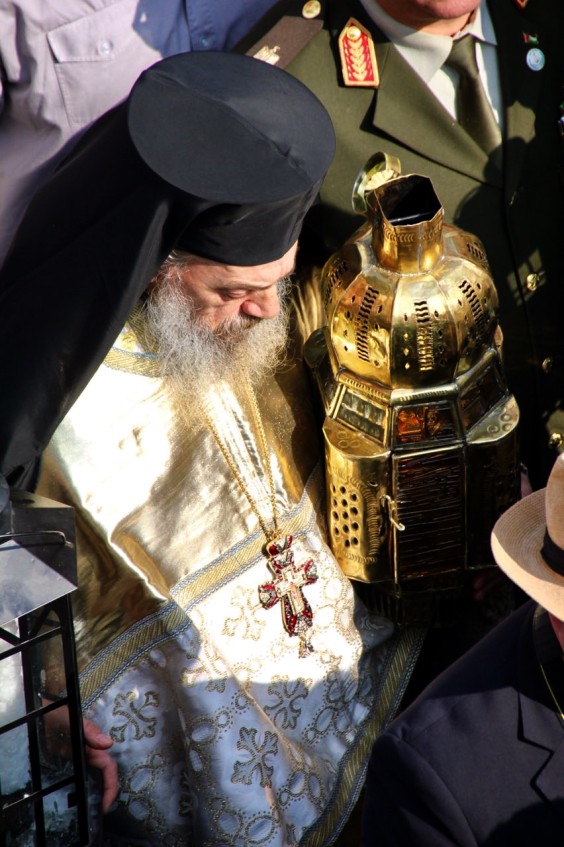
The Patriarch carrying the Holy Fire, that arrived by car from the Church of the Holy Sepulchre in Jerusalem to Beit Jala. Photo: Muzzie Rafferty
Perth Auxiliary Bishop Don Sproxton last month spent some three weeks in Israel visiting the Tantur Ecumenical Institute. wrote to The eRecord during the Easter period to speak about his experience.
In this third part of Bishop Sproxton’s experience, he describes his journey during the Easter period.
“Our Easter Celebrations began with the journey to Beit Jala for the reception of the Holy Fire from the Holy Sepulchre.
Earlier in the afternoon, the Greek Orthodox Patriarch entered the Tomb of Jesus and came out with a large flaming torch.
The crowd in the Church rushed towards him to light their torches. It did not matter who you were, everyone rushed forward.
The Patriarch had to be protected by burly guards as people crushed around him.
This tradition is very ancient. The Greeks see the new flames as the miracle that signals the resurrection of Jesus. They become very excited and you can so easily be caught up in the joy and enthusiasm of the moment.
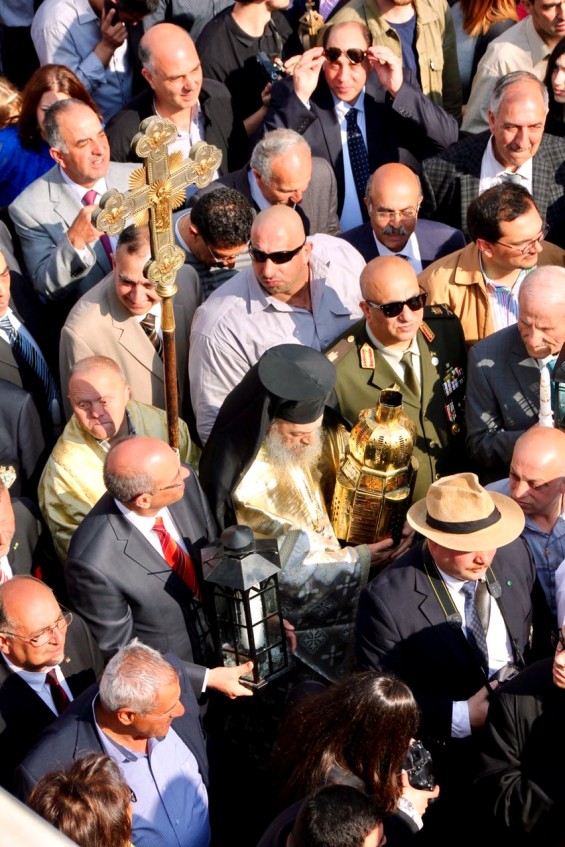
The Patriarch carrying the Holy Fire, that arrived by car from the Church of the Holy Sepulchre in Jerusalem to Beit Jala. Photo: Muzzie Rafferty
A light from the Holy Fire is sent to the great Churches in the Orthodox tradition, even as far away as Russia. Of course the Churches in Jerusalem and throughout Israel wait in the afternoon for the fire to arrive.
In Beit Jala we joined the expectant crowd. The excitement grew as the bands of bagpipers and drummers approached with the priest who carried the great lantern. The flame was taken into the Church to the sanctuary and the doors closed while the flame was prepared to be distributed to the faithful. The scene that had occurred in the Holy Sepulchre was repeated: the crowds of people rushed to receive the light of the Risen Christ. There was excitement, joy and shouts of acclamation.
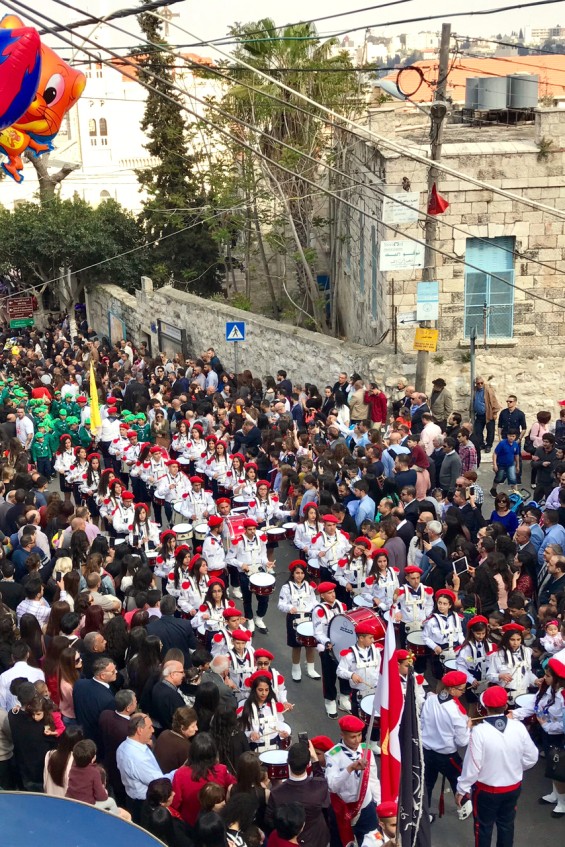
A street procession in Beit Jala awaiting the arrival of the Holy Fire. Photo: Gemma Thomson
We left to prepare for the Easter Vigil at Ecce Homo. Admittedly, our Service of the Fire was quite reserved by comparison to the Holy Fire ceremony, yet moving, as we blessed the New Fire on the terrace overlooking the Old City, the Dome of the Rock in the distance and the Sepulchre Church which is so near.
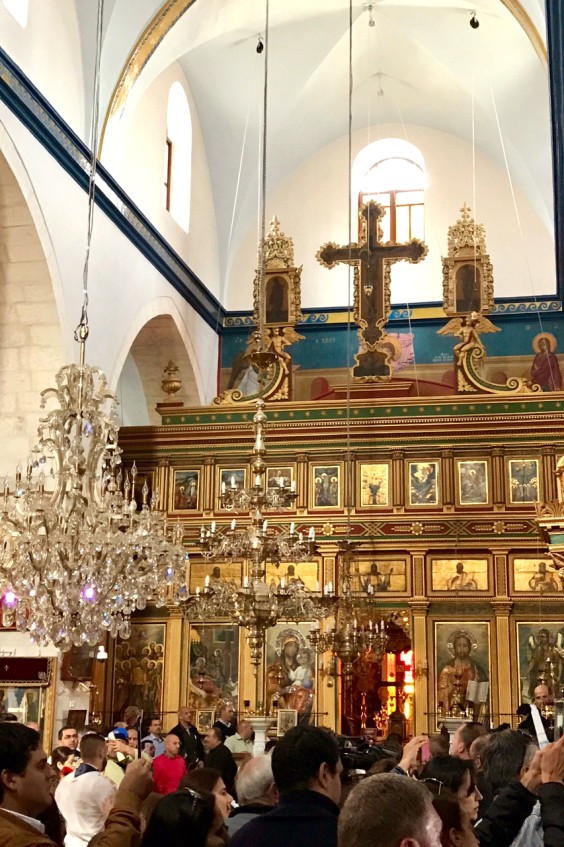
The Holy Fire arrives at the Orthodox Church. Photo: Gemma Thomson
We descended to the chapel for the Vigil of Readings and the Baptismal Renewal. We were united once more in the Eucharist, celebrated for the first time since Holy Thursday.
Following some coffee and refreshments provided by the Sisters, we set out for the Holy Sepulchre. We knew it would be crowded, but that did not matter. Where better to be on the great night of the Resurrection feast!
So we joined the great line of pilgrims from all parts of the world as they moved steadily to the tomb. The crowd was noisy. But this was so because of the excitement in the hearts of each pilgrim to be in the place where God raised Jesus to the new life of the Resurrection.
Outside, a large group of Ethiopian pilgrims formed a great circle as they danced and sang at the top of their voices, praising God for his love and mercy.
Christians, as well as some Muslims and Jews urged them on. One of our guides, a young Jewish woman, had gone to the Church to visit the tomb. She does this to show her respect for Jesus and the Christian belief in the resurrection
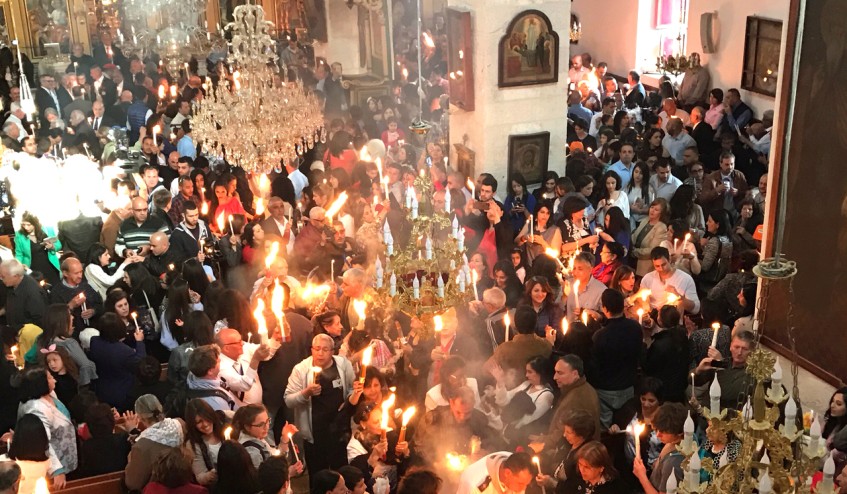
Pilgrims spreading the Holy Fire via candles in the Orthodox Church. Photo: Gemma Thomson
We returned to the Old City on Easter Sunday. Again, the city was bursting with people and was alive. The Church bells rang at several times during the day. Being the first day of the working week, most of the shops and markets were open. Our wanderings took us through most of the city, and like a magnet, we were drawn back at the Sepulchre late in the afternoon. This time the place was not so crowded. The next morning, we were back to celebrate Mass at the Catholic altar on Calvary. The time you are given is about 25 minutes. The realisation of where you were and what was achieved for us there is homily enough: more words are not necessary.
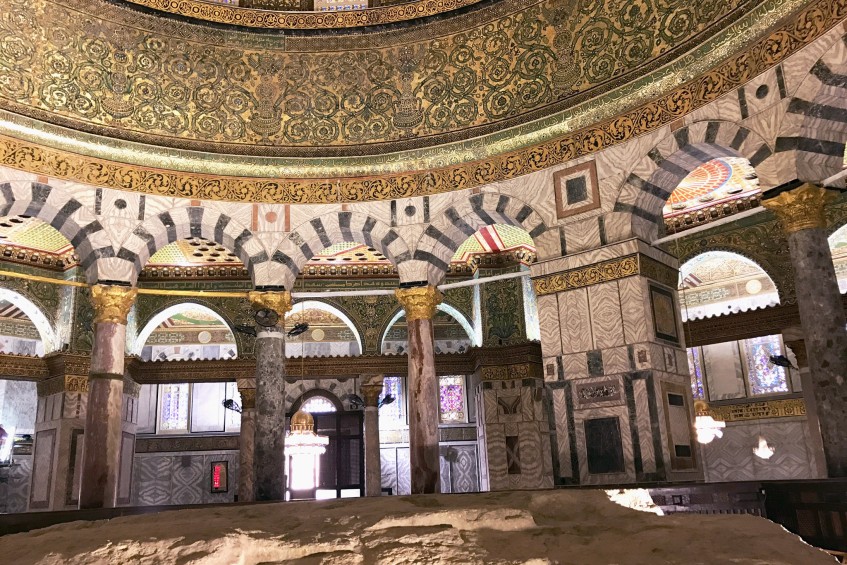
Inside the Dome of the Rock. Photo: Gemma Thomson
Early on Easter Tuesday, we began our journey to Galilee. The Evening Prayer of Easter Sunday had included the words of the Risen Christ to the disciples: Go to Galilee where you will see me. It was with this in mind that we set off.
We made for Caesarea Maritima which was transformed from a small fishing town by Herod the Great. This city became the major entry point to Palestine for the traders. The King was a great builder but indifferent to the faith of the Jews. Most Jews of the time had contempt for the man. He relied on the favour of the Romans, and his cities reflect this in their style and names. The aqueduct to the city is remarkable and in reasonably good shape in the part that follows the Mediterranean shore.
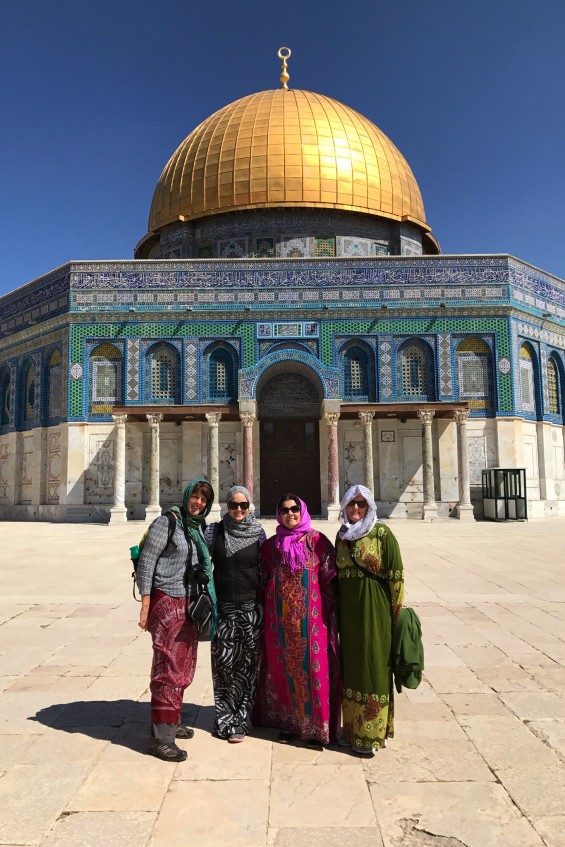
Perth pilgrims outside the Dome of the Rock. Photo: Gemma Thomson
After lunch, we drove to Mount Tabor and the Church of the Transfiguration. The Church stands on the very top of the mountain. From the Church, the view across the valley is breathtaking. Nazareth can be seen on a range of hills to the south. Lower Nazareth is mostly Christian and Muslim, and Upper Nazareth has been built in more recent times and is largely Jewish. We were able to celebrate Mass in the main part of the Church.
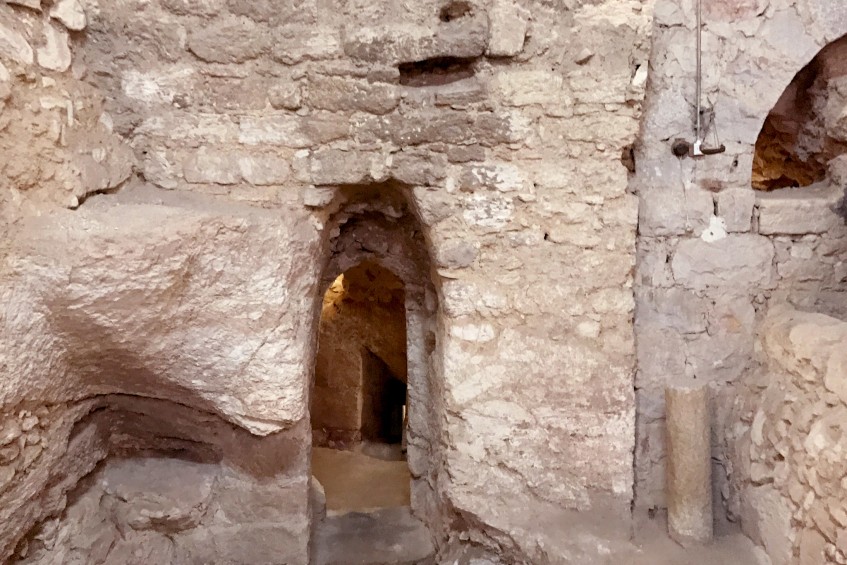
Underground excavations under the Sisters of Nazareth convent. Photo: Gemma Thomson
We stayed in Nazareth at the house of the Sisters of Nazareth. Following the evening meal, some of the group went exploring. The Basilica of the Annunciation is less than 50 metres from the guest house. We were able to join pilgrims for the Rosary in the Basilica, around the grotto, where the remains of Mary’s house are located, where she was preparing to begin her marriage with Joseph. Her encounter with the Angel occurred in this dwelling, when she was invited to become the mother of the Saviour. The Rosary was led in Italian, French, English, Spanish and Vietnamese.
The next day, we were to explore Nazareth, but not until we had a guided tour of the excavations beneath the Sisters’ house. The diggings have exposed a house of the first century and a chamber beneath in which two tombs had been dug into the rock. Above one, a hole in the rock was found in which a huge amount of incense had been sealed. When the hole was opened the aroma of the incense filled the house for several days. The incense had been there, it is reckoned, for 1700 years. Whose grave was it? Could it have been the grave of Joseph? Was the house that of Joseph? There is growing consensus that it might have been, given the reverence that has been shown for the site. If so, Mary and Jesus lived there for the best part of 27 years.
From the Nazareth Sisters, we went to the Church of St Joseph for Mass and on to the Synagogue Church. We recalled the Sabbath in the synagogue of Nazareth when Jesus took the scroll of Isaiah that was handed to him and read it for the congregation. Initially his choice of reading pleased the Jews, but they were angered by his interpretation. They would have killed him by throwing him from the nearby cliff, but he escaped. This was how his mission to his people began, the mission that would extend to every nation from Jerusalem.
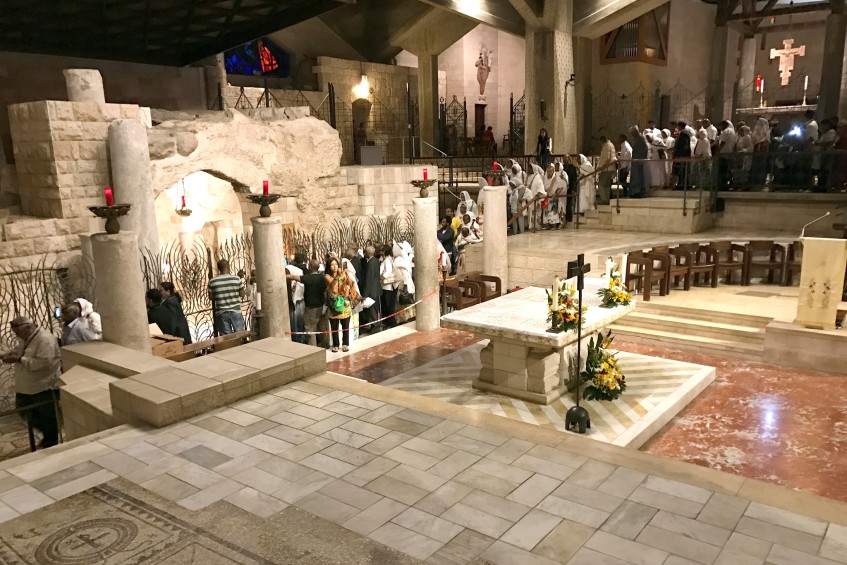
The Basilica of the Annunciation in Nazareth. Photo: Gemma Thomson
We journeyed on to Sepphoris. This was a city built by Herod Antipas that was decidedly Greek in style. It is of interest to Christians because it was being developed at the time that Joseph, Mary and Jesus returned to the obscurity of living in Nazareth. Tradesmen would have been required to complete the building projects and possibly Joseph could have sought work there. The city became an important centre for the Byzantines and the Crusaders in later times, and was believed to be the birthplace of Mary’s mother, St Anne.
We spent the next two nights at Tiberias, a city begun by Herod the Great and named after the Roman Emperor. The Lake of Galilee was renamed to honour the same emperor by the king. The French Emmanuel community provided our accommodation in a building overlooking the lake, with the Golan Heights to the east. Our first day there was devoted to making a pilgrimage to the Churches of the Beatitudes, Tabgha (the place of the multiplication of the loaves and fish), the Primacy of Peter (the place where Peter was reconciled with Jesus after the Resurrection and he was given custody of the mission of the Church), and the House of Peter in Capernaum.
The day concluded with Mass on a boat as we sailed on the Lake of Galilee.
Our final day in Galilee took us to Tel Dan National Park on the border with Lebanon. The Tel is a man-made hill created as settlements have been built one upon another over thousands of years. The land was taken in the occupation of Canaan by the Hebrews and became the territory of Dan. Abraham went there to free his nephew Lot, when the town was called Laish. The earliest settlements go back to the fifth millennium before the birth of Jesus. Laish was named Dan after it was conquered by the tribe of Dan. A significant fossilised tablet from the ninth century before Christ was found there on which is written “House of David”. This is the first time a reference to David was found outside of the Bible. When the Kingdom was divided after Solomon, Dan became another centre of Hebrew worship with a temple built there to the same dimensions as the Temple in Jerusalem.
We continued on to Caesarea Philippi, now known as Banias. Along the sides of the crystal clear river that flows before a massive rock formation are the remains of this once grand city. The cave in the side of the rock had been considered sacred by the Greeks and Romans, who both built temples there. It was at Caesarea that Jesus gave Simon the name Peter, when he responded to the question Jesus asked the disciples about who they thought he was. Peter declared “You are the Christ, the Son of the living God”. Peter would be the rock upon which the new faith and Church would be built. All of this occurred in the shadow of this huge rock at Caesarea.
Our journey through Galilee and the Golan region concluded as we stopped near the Syrian border, close to a UN outpost and centre for refugees. A little distance from the outpost, stand the ruins of the town of Quneitra that was destroyed in the conflict between Syria and Israel. A new town has been built within Syria about ten kilometres away from the border. We did not want our stop at the lookout to be less than a moment for us to pray for the people who have been caught up in the wars and conflicts of the region. We promised ourselves that we would pray for them and for peace as we did on that morning.
